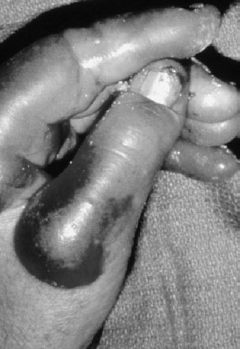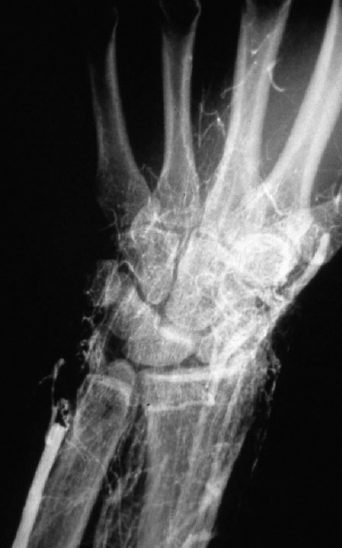2
Injuries to the Dermis: Cold Injuries
Sokratis Varitimidis, Robert J. Goitz, and Dean G. Sotereanos
History and Clinical Presentation
A 48-year-old, right hand dominant man was admitted to the emergency room 24 hours after a fall from a 20-foot height while hiking. The hikers who found the patient reported he had been exposed to temperatures below 0°C with only a light blanket.
Physical Examination
On examination, the patient denied pain, but his left hand was discolored and mottled, and he had diminished sensation. He was unable to flex or extend the fingers of his left hand. His core body temperature was 34°C, and his vital signs were normal. His body was immediately rewarmed with warm oral and intravenous fluids. Tetanus prophylaxis was given and the affected hand was placed in circulating warm water (42°C) for 30 minutes.
Within 24 hours, blisters were noted on his digits (Fig. 2–1) and he had significant pain. The hand continued to exhibit diminished sensation, and the digits appeared ischemic. The entire skin of the hand was covered with aloe vera ointment and dressed with a sterile soft dressing. An axillary block was performed to provide a sympathetic block to aid in pain control.
PEARLS
- Rapid rewarming of the hand in a whirlpool at 40° to 44°C for 15 to 30 minutes
- Protection of the skin with aloe vera or silver sulfadiazine is encouraged. Consider blister aspiration
- Administration of a nonsteroidal antiinflammatory drug (NSAID) if not contraindicated by other medical problems.
- Observe for ischemia and demarcation for up to 2 months before amputation is performed.
- Triple-phase bone scan may help guide early salvage with debridement and flap coverage if young age or bilateral involvement.
PITFALLS
- Slow rewarming may cause more tissue damage.
- Early debridement of blisters should be avoided.
- Amputation of the frostbitten part before a clear line of demarcation appears is strongly contraindicated, unless aggressive early salvage is considered.
Diagnostic Studies
Three days after admission, a bone scan was performed. It showed no activity in the fingers or distal palm. An arteriogram of the left upper extremity revealed no flow distal to the wrist (Fig. 2–2).

Figure 2–1. Blisters developed on the left hand 24 hours following rewarming.

Figure 2–2. Arteriogram without flow distal to the palm.
Differential Diagnosis
Acute frostbite
Raynard’s disease
Raynard’s syndrome
Vascular disease
Neurogenic disease
Acute Frostbite
The diagnosis of acute frostbite injury can be made immediately by the patient’s history and examination. Acute thrombosis may be considered but is less likely when considering the history of extended cold exposure.
Diagnosis
Frostbite of the Hand
Stay updated, free articles. Join our Telegram channel

Full access? Get Clinical Tree








